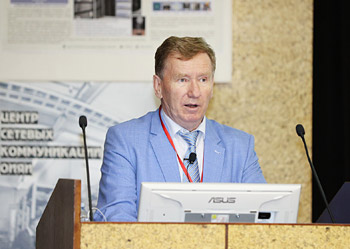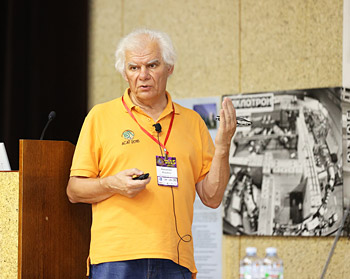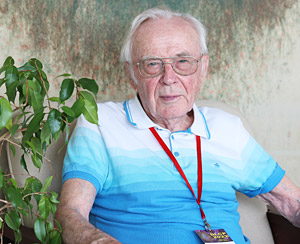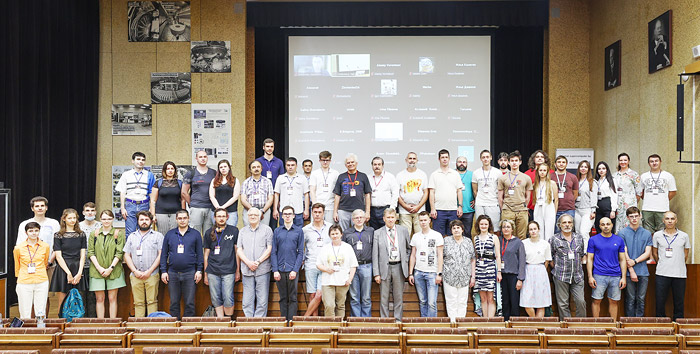
Electronic english version since 2022 |
The newspaper was founded in November 1957
| |
Workshops
JINR remains an attractive centre
The 6th International Workshop on Deep Learning in Computational Physics (DLCP 2022) was held at MLIT JINR on 6-8 July in a mixed format. It was mainly dedicated to the use of machine learning in particle astrophysics and high energy physics, but was not limited to these areas. Topics of the workshop also included various applications of artificial neural networks to physical problems, the development of new advanced machine learning methods for analyzing various scientific data, including big data. The workshop was attended by specialists from SINP MSU, MEPhI, NRC "Kurchatov Institute", state universities of Irkutsk, Moscow, St. Petersburg, Tver, Tula, universities of India, Serbia, Slovakia, as well as employees of JINR laboratories.
Opening the workshop, MLIT Director V.V.Korenkov noted, "Deep machine learning is extremely essential in all research areas of the Institute and the work carried out by MLIT in this area will be presented in reports at the workshop." In his introductory report, he spoke about the areas of work of the Laboratory, participation in major projects of JINR and CERN, as well as the development of the Multifunctional Information and Computing Complex. Our correspondent talked to Director of MLIT:
 "The workshop-conference "Deep machine learning in the scientific field" is a traditional event of Moscow State University. They have already held several such rather local events focused only on the use of deep machine learning methods in various fields of science, mainly in nuclear physics, high energy physics and astrophysics. A few months ago colleagues turned to us with a request, firstly, to expand the subject matter of the conference a little and, secondly, to hold this event in Dubna. We are very interested in this topic and in a wider range, not only in high energy physics and astrophysics, but also in economics, the social sphere, biology, medicine and so on. Today deep machine learning is very widely used in various fields. So, we hold it here for the first time, but I would not say that we have no direct relationship to this conference, of course, we do. This topic is very relevant for us; we are engaged in deep machine learning for new megascience projects. For all experiments of the NICA project, both tracking and data analysis methods are carried out, they are also applied in the Baikal GVD project, we implement much work in radiobiology and nuclear medicine.
"The workshop-conference "Deep machine learning in the scientific field" is a traditional event of Moscow State University. They have already held several such rather local events focused only on the use of deep machine learning methods in various fields of science, mainly in nuclear physics, high energy physics and astrophysics. A few months ago colleagues turned to us with a request, firstly, to expand the subject matter of the conference a little and, secondly, to hold this event in Dubna. We are very interested in this topic and in a wider range, not only in high energy physics and astrophysics, but also in economics, the social sphere, biology, medicine and so on. Today deep machine learning is very widely used in various fields. So, we hold it here for the first time, but I would not say that we have no direct relationship to this conference, of course, we do. This topic is very relevant for us; we are engaged in deep machine learning for new megascience projects. For all experiments of the NICA project, both tracking and data analysis methods are carried out, they are also applied in the Baikal GVD project, we implement much work in radiobiology and nuclear medicine.
This topic is part of our MMCP conference, so it is not surprising that more than 120 participants registered here, while at Moscow State University 30-35 people participated in these workshops. The programme is interesting, very diverse, we hope the conference will be useful for the development of this area in our Institute and in Member States, representatives of which were able to take part in it. The team of St. Petersburg State University also arrived, which we carry out a lot of work in this area together with. Many graduates or postgraduates of SPbU have prepared papers on our topics. I am Head of the State Examination Commission for the defense of master's theses at SPbU and this year almost half of the submitted papers were performed on JINR topics, as a rule, using deep machine learning. Many Ph.D. dissertations at SPbU are prepared jointly with our Laboratory."
"Will this conference become a traditional LIT conference?"
"We have not yet discussed further plans, perhaps the conference will become our traditional one or will be held together with Moscow State University. The SINP MSU team that was involved in this conference, is headed by Aleksandr Pavlovich Kryukov whom we have known for a long time, did a lot of computing for LHC and represented Russia in various committees."
 "It all started five years ago with a joint project of SINP and KIT (Karlsruhe Institute of Technology, Germany)," Co-chairman of the organising committee of the conference (SINP MSU) A.P.Kryukov says. "At the same time, this movement towards machine methods in particle astrophysics started. The fact is that the basic experiment on which this cooperation was developed is gamma-ray astronomy based on the TAIGA-Tunka project. A gamma-ray observatory is deployed in the Tunkinskaya Valley near Baikal. It has a long history, but recently the project has been developing rapidly, there are already three Cherenkov telescopes and two more are designed. This is a joint project, including with Dubna that has made a great contribution to it. The older Tunkan-133 facility has been expanded and updated and is called TAIGA-HiSCORE that is also a Cherenkov telescope. There are several basic tasks in gamma-ray astronomy: the first is to isolate the signal itself and there are 10000 protons per gamma-ray event and this is a very difficult task. And if we are able to isolate a gamma event, then we can further carry out a physical analysis and obtain the very spectra with the use of which we can judge the nature of the source, the nature of gamma rays and solve other problems in astrophysics.
"It all started five years ago with a joint project of SINP and KIT (Karlsruhe Institute of Technology, Germany)," Co-chairman of the organising committee of the conference (SINP MSU) A.P.Kryukov says. "At the same time, this movement towards machine methods in particle astrophysics started. The fact is that the basic experiment on which this cooperation was developed is gamma-ray astronomy based on the TAIGA-Tunka project. A gamma-ray observatory is deployed in the Tunkinskaya Valley near Baikal. It has a long history, but recently the project has been developing rapidly, there are already three Cherenkov telescopes and two more are designed. This is a joint project, including with Dubna that has made a great contribution to it. The older Tunkan-133 facility has been expanded and updated and is called TAIGA-HiSCORE that is also a Cherenkov telescope. There are several basic tasks in gamma-ray astronomy: the first is to isolate the signal itself and there are 10000 protons per gamma-ray event and this is a very difficult task. And if we are able to isolate a gamma event, then we can further carry out a physical analysis and obtain the very spectra with the use of which we can judge the nature of the source, the nature of gamma rays and solve other problems in astrophysics.
There has been a perception that it is necessary to develop new methods, since the old ones have actually exhausted themselves, have reached a certain limit. Recently, machine learning methods have become of great importance, at present there is a wave of publications on this topic in almost all fields of science. Today we heard reports on collider physics and astrophysics, but in fact it is biology, linguistics, ordinary services that many people got used to, such as Alice's voice assistant, Google services - these are all neural networks in one form or another. Knowing about the great potential of these methods, we started to develop this area and organised the first meeting and then it became traditional and international. Unfortunately, this time the number of foreign participants is small, yet we believe that the international status is preserved and we hope that there will be further development. Dubna's help in its organisation this year is key.
What surprised me this year? We have organised fairly narrow meetings, bringing together 25-30 people, yet we have never limited ourselves to astrophysics and high energy physics, we always included applications in biology, meteorology and other areas. The methods are common in order to analyse the huge data flow that are obtained not only from LHC-type facilities, but also from Earth monitoring, for instance. But this year the number of participants wishing to speak has at least doubled. Taking into account the occurrence of a good educational base in Dubna in the form of a university with which JINR cooperates and the essence of the educational moment in terms of preparing a shift, we have added the section "Machine learning in education". On the one hand, this is an opportunity to express how we can train specialists in this field with a bias in physics and on the other hand, to give young people, maybe even students, the opportunity to present their theses in the form of posters."
 V.A.Rudnev, a representative of SPbU, spoke about the permanent participation of the university in many LIT conferences.
V.A.Rudnev, a representative of SPbU, spoke about the permanent participation of the university in many LIT conferences.
"First of all, it should be noted that there are long-term scientific relationships between our university and JINR that have been developed, probably, since the very moment of the establishment of the Joint Institute. Of course, I am speaking a little from the outside in the sense that I represent that side of computational physics more and there are a lot of people here who deal with more or less abstract mathematical problems, algorithmic problems, although in applications to physics, yet this conference, nevertheless, is focused on the method. I am interested in some physical applications that would allow to advance the simulation of complex quantum systems to a conceptually new level. Those computing technologies, the technique that is the subject of this conference, it just gives hope to make a colossal breakthrough precisely in the field of solving complex quantum mechanical problems. Actually, I came to inform my colleagues about this. And if we do this, we can ensure technological dominance in the field of nanotechnology, where complex quantum effects begin to play a significant role.
There are systems that we physically cannot calculate even on advanced, the most "terrible" computers that we were told about here, they are not enough to solve these problems. There is a chance when the right techniques are applied to solve them and those techniques have yet to be developed; let it be only reasonable, but there is still a hope. Our task is to turn this hope into real technology and communicating with a range of people who are engaged in advanced computing technologies related to deep machine learning, with neural networks is essential for me. And of course, there are long-term relationships between MLIT and SPbU and I represent the Department of Computational Physics, our graduate students defend their theses here. And as a theorist by origin, I have long-term relationships with BLTP, I hope to visit my comrades this time. These relationships, despite all the difficulties of our lives, remain the same and JINR remains an attractive centre where one can find a healthy scientific atmosphere that is a rare phenomenon today, in the conditions of a strong bureaucratization of science. It is this atmosphere that draws us here again and again."
"Did you come here with young colleagues?"
"You see, there is a problem with young colleagues, especially with graduate students. The work of a graduate student is such that you have to devote yourself entirely to it, if you do not have the physical ability to survive at the same time and the graduate student's salary does not provide such an opportunity, then all talented young people will solve, first of all, the tasks of survival. Those who have this task solved can somehow participate in the development of science, but the current social situation completely cuts off the future of Russian science, or rather, it cuts off Russian science from its future."
"On this sad note, we will end our interview ..."
"Well, it's not that the note is completely sad, it's a reality, yet we never leave the hope that something can change, that we can try to change something."
 G.A.Ososkov presented the report on "Machine learning at MLIT. History, challenges and prospects" at the conference. "Machine learning is what I have been doing for 60 years at JINR. I didn't know at first that the methods of processing experimental data are the methods of machine learning." The speaker spoke about the classical methods of machine learning and advanced methods that appeared with neural networks; showed the main stages of the analysis of experimental data in high energy physics experiments; dwelled on advanced challenges - the NICA project with BM&N, MPD and SPD experiments; presented examples of the successful use of neural networks. And it all started in 1966, when M. G. Meshcheryakov, being a physicist, became Director of the new Laboratory and categorically insisted that the LCTA should start processing experimental data ..."
G.A.Ososkov presented the report on "Machine learning at MLIT. History, challenges and prospects" at the conference. "Machine learning is what I have been doing for 60 years at JINR. I didn't know at first that the methods of processing experimental data are the methods of machine learning." The speaker spoke about the classical methods of machine learning and advanced methods that appeared with neural networks; showed the main stages of the analysis of experimental data in high energy physics experiments; dwelled on advanced challenges - the NICA project with BM&N, MPD and SPD experiments; presented examples of the successful use of neural networks. And it all started in 1966, when M. G. Meshcheryakov, being a physicist, became Director of the new Laboratory and categorically insisted that the LCTA should start processing experimental data ..."
I asked Gennady Alekseevich about history after his speech.
"Mikhail Grigorievich was very puzzled when he was offered to head a new laboratory. And although there was even some kind of battle for being the head of the laboratory, but since organizational issues were not clear to the directorate at that time and high costs were required, they remembered Meshcheryakov. Everyone counted on his old relationships in the ministry and his ability, like a tank, to break through any problems. He sat out for a while after his resignation. And I must say, these were the best years of his life - he finally took up decent physics, made significant discoveries. On reflection, he agreed to this proposal. The only condition he set was that it would not be a data center. He said: "I understand little about these things, I understand physics, and I see that today the main problem for physicists is the lack of scanners that would read film information." At that time, experiments were carried out on various kinds of bubble chambers and their results were photographed. Millions of photographs had already been accumulated and although 70 viewers each worked at CERN and JINR, they failed - automation was required. And at CERN, such a process has already begun.
Meshcheryakov took this rather fundamentally. He went to the USA and directly asked the Nobel laureate L. Alvarez what the most reasonable thing was to quickly process images in automatic mode? He answered: a spiral gauge. Meshcheryakov came up with the idea to launch mass production of spiral meters in Dubna in order to supply all the physical centers of the USSR and perhaps, the socialist countries. His grandiose plans did not come true for various reasons, mainly due to the low level of technological development in the country. But when he started his cyclotron, he showed that he could gather people and make everything work. This time he did the same: he took the list of JINR employees and gathered around him all the necessary specialists. So Yura Karzhavin appeared with the automation department, electronics specialists providing this automation and a rather large laboratory developed. He looked far ahead, the only thing he could not foresee was the rapid development of electronic experiments. Then there was not even the idea of drift chambers and later collider experiments appeared, so what he came up with, unfortunately, did not last very long. The most interesting thing is that almost all the tasks that we solved then are still a storehouse of useful algorithms for me, many ideas and inventions are still urgent.
Mikhail Grigorievich was close to me. He sent me, overcoming my objections, to CERN to study this spiral meter. To study seriously: I had to come up with programs moving parts of this meter. They developed programs in autocodes and I wrote a language for controlling automata, wrote my translator into that machine code. It is a pity that JINR was not able to purchuase such a large and expensive machine as it was at CERN and all my developments were not very useful."
"Please, tell us in more detail about the challenges you face now."
"Our small team makes programs for reconstructing the events of future experiments at the NICA complex. A.S.Zhemchugov has already involved us in DLNP issues related to SPD. We have completely new approaches in neural networks that we are going to use. For instance, the ability to use a convolutional neural network to present a spatial image of the entire SPD event under study that allows, in particular, to find the coordinates of its vertex before all tracks are recognized, as it is currently carried out. The only thing is that we currently do not have enough computer resources to place this huge digital representation of the event in the computer's memory, but what we have managed to implement already demonstrates the great promise of this approach.
The main issue in the reconstruction of events using neural networks is that due to the strict requirement not to lose useful tracks with high recognition efficiency, the neural network can allow the occurrence of false, non-existent tracks. They are unacceptable for physicists, they should not be more than 4 percent and currently their number reaches 20 percent in our country. Today we are faced with a real challenge: using fine-tuning of the parameters of the applied neural networks and networks such as graph and transformers to increase the efficiency of reconstruction results with the suppression of false tracks."
***
The presentations at the 6th conference ranged from energy reconstruction in the analysis of images of Cherenkov telescopes and deep neural network applications for particle tracking in the BM&N and SPD experiments to estimating the accuracy of COVID-19 evolution models and recovering missing data in solving inverse problems of exploration geophysics. Where else one can use the capabilities of machine learning and neural networks, we will find out at the next conference.
Olga TARANTINA,
photo by Igor LAPENKO
